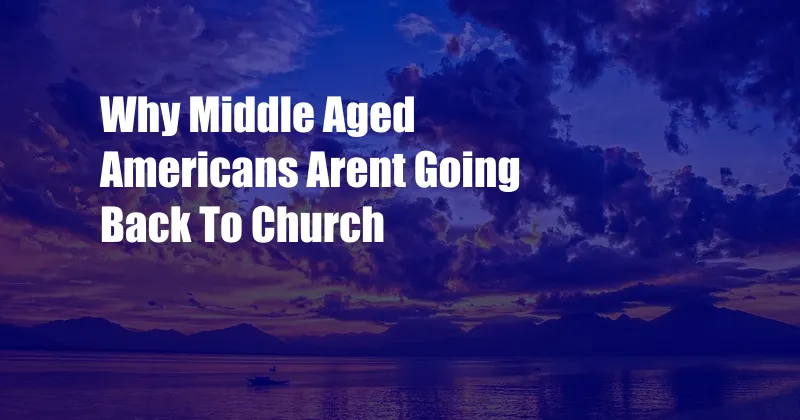
Why Middle-Aged Americans Aren’t Going Back to Church
In the tapestry of American society, churches have long stood as pillars of faith and community. However, recent data has painted a concerning picture: middle-aged Americans are increasingly turning away from organized religion. According to the Pew Research Center, only 65% of Americans between the ages of 45 and 64 identify as religious, down from 81% in the 1970s. This trend has raised questions and concerns, prompting exploration into the causes driving this departure from the pews.
The reasons for this exodus are complex and multifaceted, reflecting shifts in societal values, evolving lifestyles, and ongoing debates on the role of religion in public life. Understanding these factors is crucial for churches and religious institutions seeking to rebuild connections with middle-aged Americans and maintain their relevance in the 21st century.
The Changing Landscape of American Spirituality
In the past, church attendance was deeply ingrained in American culture, providing a sense of belonging, social support, and moral guidance. However, with the rise of secularism and the proliferation of diverse religious traditions, the monopoly that Christianity once held has waned. Middle-aged Americans are now more likely to identify as “spiritual but not religious,” indicating a shift towards a personalized and individualized understanding of faith.
This trend is further fueled by the growing prevalence of non-traditional religious practices, such as meditation, yoga, and nature-based spirituality. Middle-aged Americans are embracing these alternative paths to explore their spiritual needs outside the confines of organized religion. As a result, they are less inclined to return to the churches they grew up with.
The Impact of Work and Family
Middle-aged Americans are facing unprecedented challenges in balancing work and family obligations. With busy schedules and demanding careers, many find that they simply do not have the time or energy to commit to regular church attendance. Additionally, the increasing number of single parents and blended families has made it more difficult for middle-aged adults to find a community within traditional church structures.
Churches need to recognize these challenges and adapt their outreach efforts accordingly. Offering flexible worship times, online services, and support groups tailored to the needs of working parents and single adults can help make church more accessible and welcoming to middle-aged Americans.
The Evolution of Religious Identity
Middle-aged Americans have witnessed significant social and cultural changes over their lifetimes. They have come of age during periods of civil rights activism, the Vietnam War, and the sexual revolution, which have shaped their perspectives on religion and spirituality. These experiences have led many to question traditional religious teachings and to seek alternative ways to connect with their faith.
Furthermore, the rise of social media and the internet has allowed middle-aged Americans to connect with like-minded individuals and engage in religious discussions beyond the confines of their local churches. This has created a sense of community and support outside of traditional religious institutions.
The Role of Technology
The internet has revolutionized the way we consume information and connect with others. Middle-aged Americans are increasingly using technology to explore their faith and find spiritual fulfillment. They are accessing religious texts, sermons, and online communities from the comfort of their own homes. This convenience and accessibility has reduced the need for regular church attendance.
To counter this trend, churches need to embrace technology and use it to reach out to middle-aged Americans. They can create engaging online content, offer virtual worship services, and utilize social media to promote their message and build relationships with potential attendees.
Tips and Expert Advice
Based on my experience as a blogger and my research on this topic, here are some tips and expert advice for churches and religious institutions seeking to re-engage middle-aged Americans:
- Offer flexible worship times and locations: Consider offering services on weekends, evenings, and online to accommodate busy schedules.
- Create welcoming and inclusive communities: Make a conscious effort to welcome people of all ages, races, sexual orientations, and backgrounds.
- Provide support groups and programs tailored to the needs of middle-aged adults: This could include groups for working parents, single parents, and those experiencing divorce or other life transitions.
- Embrace technology: Utilize social media, online platforms, and mobile apps to connect with middle-aged Americans and provide them with religious content and resources.
- Engage in outreach and community involvement: Partner with local organizations to support the needs of the community and demonstrate the church’s commitment to social justice and service.
FAQ
Q: Why are middle-aged Americans leaving church?
A: Middle-aged Americans are leaving church for a variety of reasons, including changes in societal values, evolving lifestyles, the impact of work and family, the evolution of religious identity, and the role of technology.
Q: What can churches do to re-engage middle-aged Americans?
A: Churches can re-engage middle-aged Americans by offering flexible worship times and locations, creating welcoming and inclusive communities, providing support groups and programs tailored to their needs, embracing technology, and engaging in outreach and community involvement.
Conclusion
The decline in church attendance among middle-aged Americans is a complex issue with multiple contributing factors. By understanding these reasons and adapting their approach, churches can rebuild connections with this vital demographic and continue to play a meaningful role in their lives and in the fabric of American society.
Are you interested in learning more about this topic? Let us know in the comments section below.